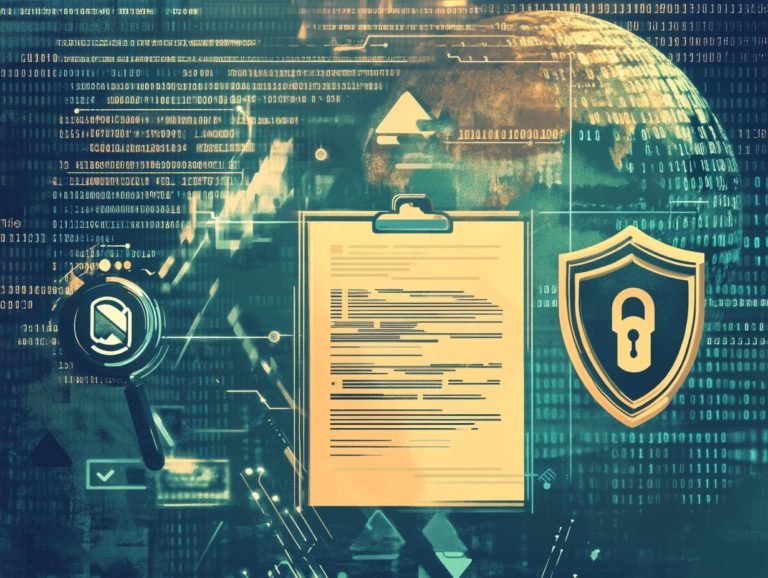how to train employees on compliance regulations
In today’s highly regulated business environment, understanding compliance regulations is crucial for organizations and their employees.
This guide serves as your roadmap for understanding the complicated rules of compliance. It will help you identify key regulations specific to your industry and highlight the critical role of employee training.
You ll discover best practices for developing, implementing, and assessing effective training programs. By prioritizing compliance education, you can cultivate a culture of accountability and integrity, benefiting both your organization and its workforce.
Contents
- Key Takeaways:
- Overview of Compliance Regulations
- The Importance of Training Employees on Compliance Regulations
- Identifying Key Compliance Regulations for Your Industry
- Developing an Effective Training Program
- Putting the Training Program into Action
- Evaluating the Success of the Training Program
- Maintaining Compliance in the Workplace
- Preguntas Frecuentes
- Qu son las regulaciones de cumplimiento y por qu es importante capacitar a los empleados en ellas?
- C mo determino qu regulaciones de cumplimiento necesitan capacitaci n mis empleados?
- Cu les son algunos m todos efectivos para capacitar a los empleados en regulaciones de cumplimiento?
- Cu les son algunos desaf os comunes al capacitar a los empleados en regulaciones de cumplimiento?
- C mo puedo asegurarme de que mis empleados han comprendido la capacitaci n en regulaciones de cumplimiento?
- Necesito proporcionar capacitaci n continua sobre regulaciones de cumplimiento?
Key Takeaways:
- Follow compliance regulations to protect your business and avoid legal issues.
- Train employees on compliance regulations to empower them with knowledge and skills.
- Research and identify key compliance regulations specific to your industry to design effective training programs.

Overview of Compliance Regulations
Compliance regulations provide essential guidelines to help organizations navigate the complex landscape of laws, industry standards, and corporate policies governing their operations.
These regulations protect the interests of businesses and uphold employee rights, promoting a safe workplace. Understanding compliance regulations is key to reducing the risks of legal violations and ensuring a strong workplace culture based on ethical standards.
Organizations must act now to implement effective compliance training programs that educate employees about their responsibilities, ensuring adherence to legal requirements. This proactive approach fosters a safe work environment and aligns the organization with regulatory compliance frameworks.
What are Compliance Regulations?
Compliance regulations encompass the essential laws, standards, and guidelines that businesses must follow to operate within legal and ethical boundaries. These regulations can vary significantly, covering critical areas such as data protection laws, which secure personal information management, and workplace safety regulations, which aim to create a safe environment for employees.
Anti-harassment policies are vital for fostering a respectful workplace culture. Organizations that fail to adhere to these regulations may face serious consequences, including fines, legal action, and damaged reputations.
Conversely, embracing compliance shields you from penalties and fosters trust with clients and employees, enhancing your operational integrity and paving the way for long-term success.
The Importance of Training Employees on Compliance Regulations
Training employees on compliance regulations is essential for building a culture of accountability and transparency within your organization. Effective compliance training, including how to train employees on data privacy, informs employees about their responsibilities and helps them identify potential risks and legal violations.
Integrating compliance training into both employee onboarding and ongoing education nurtures a workplace culture that emphasizes ethical conduct and regulatory adherence. This proactive strategy reduces compliance risks and enhances employee engagement and productivity, creating a safe environment where everyone understands their role in upholding corporate values.
Start today to strengthen your organization s integrity and compliance!
Benefits for the Company and Employees
The advantages of compliance training go beyond fulfilling legal requirements; they significantly uplift employee morale and enhance organizational effectiveness.
For your company, this training translates into improved productivity. When employees are well-trained, they tackle tasks with greater efficiency and accuracy. Additionally, it helps mitigate legal risks by ensuring that every team member understands regulations and policies, ultimately protecting the company from potential lawsuits.
Compliance training also leads to better workplace safety measures. This decreases the likelihood of accidents and fosters a healthier work environment. Employees benefit from a renewed sense of security, knowing they work within established guidelines, which boosts engagement and loyalty.
This collective commitment to compliance nurtures a positive workplace culture and enhances collaboration among staff, creating a harmonious and effective team dynamic.
Identifying Key Compliance Regulations for Your Industry

Identifying key compliance regulations specific to your industry is essential for crafting a robust compliance training program tailored to your organization’s needs. Each sector has unique regulatory requirements; being aware of these legal obligations is vital for mitigating compliance risks.
For example, if you’re in healthcare, you need to comply with a law that protects patient information, while those in finance must adhere to the Sarbanes-Oxley Act.
By thoroughly understanding these regulations, you can implement customized training programs that highlight the importance of compliance training programs to effectively address compliance standards and employee responsibilities.
Research and Analysis
Researching and analyzing compliance regulations involves closely examining the specific legal requirements that govern your industry s operational framework. This process starts with utilizing trusted resources, such as government websites and industry associations, which frequently offer invaluable guidelines and updates.
By systematically navigating these resources, you can gather insights on relevant codes, standards, and best practices that dictate operational activities. Make sure to check compliance content regularly to keep your training effective!
Regularly assess updates from regulatory bodies and cross-reference your findings to ensure alignment with current guidelines. This helps establish a solid foundation for effective compliance management.
Developing an Effective Training Program
Developing an effective training program demands thoughtful alignment with your organization’s values and compliance requirements. Consider creating interactive training modules that actively engage employees, significantly enhancing their learning experience.
A well-structured program fulfills legal obligations while addressing the unique compliance challenges specific to your industry.
By leveraging a learning management system (LMS), you can streamline training delivery, monitor progress, and ensure that the training content remains relevant and impactful.
Best Practices and Strategies
Implementing best practices and strategies in compliance training significantly enhances employee engagement and ensures retention of vital information. This proactive approach captures your employees attention and cultivates a culture of accountability within your organization.
To achieve this, try these interactive methods to enhance training:
- Gamification
- Scenario-based learning
- Group discussions
These techniques can transform the training experience into something enjoyable and memorable. Regular updates to training materials are essential to reflect any changes in regulations or company policies, ensuring that your content remains relevant and accurate.
Conducting training assessments serves as a valuable tool for measuring compliance metrics and identifying knowledge gaps. This enables you to adopt tailored approaches that reinforce learning where it s needed most.
Don’t wait! Start developing your compliance training program today to protect your organization.
Putting the Training Program into Action
Putting the training program into action effectively demands a strategic approach to rolling out compliance training throughout your organization.
It s essential that all employees receive necessary education during onboarding and beyond.
This process involves clear communication about training requirements, expectations, and available resources to help employees thrive.
Establish mechanisms to track progress and provide feedback, which is crucial for enhancing the training experience.
This ensures every employee is well-versed in compliance content and corporate policies.
Rolling Out and Enforcing Compliance Training

Rolling out and enforcing compliance training is key to understanding your responsibilities regarding compliance rules.
To achieve this, set clear deadlines for training completion to motivate your learning.
Offering incentives, like recognition or rewards, can encourage your full participation and timely completion.
Regularly review training materials to reinforce your knowledge and identify areas needing improvement.
Integrate compliance training into the onboarding process for new hires to provide foundational knowledge right from the start.
Stay ahead of the game by fostering a culture of ongoing education, as compliance rules are always evolving.
It s imperative to stay informed to maintain adherence!
Evaluating the Success of the Training Program
Evaluating the success of your training program is crucial for understanding its effectiveness in enhancing employee knowledge and ensuring adherence to regulations.
This assessment helps pinpoint strengths and areas for improvement, fostering a more informed and compliant workforce.
Measuring Employee Knowledge and Compliance
Measuring employee knowledge and compliance requires using assessments to evaluate their understanding and retention of training content.
These assessments can take on various forms, such as quizzes that gauge theoretical understanding and practical evaluations that test real-world application.
Quizzes act as quick checkpoints, ensuring employees grasp essential concepts.
Practical evaluations offer deeper insights into how effectively these concepts are implemented in daily tasks.
Understanding training effectiveness depends on careful analysis of assessment results.
By leveraging compliance metrics, you can pinpoint specific knowledge gaps and allow for targeted interventions that enhance overall compliance.
Recognizing where employees face challenges facilitates tailored follow-up training, cultivating a more informed and compliant workforce.
Maintaining Compliance in the Workplace
Maintaining compliance in the workplace is not a one-time task; it s an ongoing journey that demands your commitment to continuous education and training.
As regulatory standards and corporate policies evolve, stay ahead by investing in ongoing training initiatives.
This approach effectively addresses compliance risks while cultivating a culture of accountability among your team.
Take a proactive stance on continuing education to ensure that legal obligations are met.
Foster a positive workplace culture where ethical considerations are prioritized and your organization s values are upheld!
Don t wait! Start integrating compliance training today!
Continuing Education and Ongoing Training
Continuing education and ongoing training are vital to keep you informed about compliance risks and legal changes.
Employers have various ways to support your learning journey. These include webinars, refresher courses, and flexible e-learning platforms that let you learn at your own pace.
These approaches help you stay updated and understand your role in the organization s ethical framework. When training aligns with company values, it fosters a learning culture that prioritizes ethical behavior.
This alignment creates an environment where you feel empowered to make informed decisions that reflect the company s standards and mission.
Preguntas Frecuentes

Qu son las regulaciones de cumplimiento y por qu es importante capacitar a los empleados en ellas?
Las regulaciones de cumplimiento son leyes y directrices que las organizaciones deben seguir para garantizar que operan de manera legal y tica. Capacitar a los empleados en estas regulaciones ayuda a proteger a la empresa de posibles riesgos legales y de reputaci n.
C mo determino qu regulaciones de cumplimiento necesitan capacitaci n mis empleados?
El primer paso es identificar las regulaciones espec ficas que se aplican a su industria y organizaci n. Esto se puede hacer realizando investigaciones o consultando con un experto en cumplimiento. Una vez identificadas, puede priorizar cu les son las m s relevantes para la capacitaci n de sus empleados.
Cu les son algunos m todos efectivos para capacitar a los empleados en regulaciones de cumplimiento?
Los m todos efectivos incluyen sesiones de capacitaci n en persona o en l nea, seminarios web, ejercicios de juego de roles y capacitaci n en el trabajo. Tambi n es importante revisar y actualizar regularmente los materiales de capacitaci n para asegurar que sean relevantes.
Cu les son algunos desaf os comunes al capacitar a los empleados en regulaciones de cumplimiento?
Los desaf os comunes incluyen la falta de compromiso, la dificultad para entender regulaciones complejas y los recursos limitados para la capacitaci n. Abordar estos desaf os es crucial; haga que las sesiones de capacitaci n sean interactivas y proporcione informaci n clara y concisa.
C mo puedo asegurarme de que mis empleados han comprendido la capacitaci n en regulaciones de cumplimiento?
Una forma de garantizar la comprensi n es hacer que los empleados completen una evaluaci n o cuestionario posterior a la capacitaci n. Esto ayudar a identificar reas que necesiten capacitaci n adicional. Tambi n puede ser til proporcionar oportunidades para que los empleados hagan preguntas durante la sesi n.
Necesito proporcionar capacitaci n continua sobre regulaciones de cumplimiento?
S , es importante ofrecer capacitaci n continua para mantener a los empleados actualizados sobre cambios en las regulaciones. Esto tambi n refuerza la importancia del cumplimiento y su impacto en la organizaci n. Las sesiones regulares sirven como recordatorio para que los empleados cumplan siempre con las regulaciones de cumplimiento.






